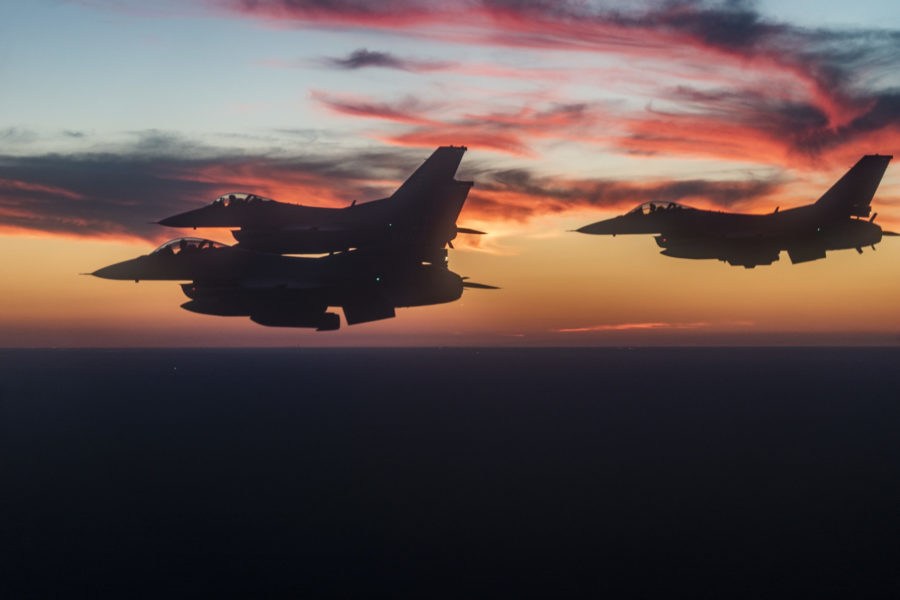Additional budget documents set to be released later this month will start to map an improvement program for the F-16, to support that type serving almost another two decades, the service’s deputy chief of staff for plans and programs said. USAF doesn’t have to decide on what the F-16’s replacement will be until 2028 or later, he added.
The F-16 will be ideal for a variety of missions not requiring high-end stealth and survivability, Lt. Gen. David S. Nahom told Air Force Magazine in an interview. The jet will continue to be USAF’s low-end, multipurpose force builder.
The F-16 can be that “one airplane that can do a lot of low-end missions, and remarkably cheaper than a fifth-generation platform, and it can do them well,” he said. It can “satisfy an objective in the Middle East and a week later, fly [combat air patrol] over a point on the U.S., and do a homeland defense sortie. It’s pretty amazing. And do that at half … [the] operating cost of any other air platform we have out there.”
Nahom asserted that, “There’s a utility to that. That’s why you’re seeing the investment in the post-block, our latest-model F-16s. Because we think we can get another 18-20 years out of them.”
The A-10, he said, is a good close air support platform for increasingly rare situations where air defenses are thoroughly suppressed or nonexistent.
“But can it do homeland defense? Well, no. …There’s a lot of things an F-16 can do. And I’ll tell you, it does pretty good CAS, too.” The Air Force has limited resources, he said, and so it makes more sense to invest in an F-16 fleet that can do a host of missions rather than the A-10, which “can only do one.”
Rather than a high-low mix, Nahom said USAF’s future fighter force structure would be better described as a bell curve with the bulk being low/medium capability F-16s and medium/high capability F-35s. At the very low end would be a small number of aircraft only able to operate in permissive environments while the upper end would be aircraft like the F-22 and the Next-Generation Air Dominance fighter, tuned to the most demanding conditions.
“So now, the question is, what replaces” the F-16, Nahom said.
“Let’s fast forward to the 2035/2036-ish timeframe. Is there still a need for that low-cost platform? I think, right now, there is,” he said. “And what does it look like? Do we replace it with another F-16-looking thing? Did the F-35 come down in cost enough where we can buy more of them? Is it something else? Is it unmanned at that point, because we can do things differently?”
All of that, he said, is “a question for another day. The good thing is, we don’t have to do anything right now. We’ve got 18-20 years of life left on 600-plus F-16s that are doing great work for our nation.” The decision on how it will be replaced is “probably six, eight years away,” he said.
In the meantime, USAF can concentrate on “getting the F-35 right,” recapitalizing squadrons with F-35s and F-15EXs, and increasing the overall capacity of the force, while developing the “NGAD family of systems and upgrading the [F-22] Raptor in the meantime.”
The Air Force doesn’t have to make any decisions about a near-term, low-cost manned platform because it has the post-block F-16s, Nahom said. And, though he acknowledged the modifications are “expensive,” he said, “for what we’ll get out of that airplane, it’s well-spent money.”
Nahom did not discuss what improvements will be coming for the F-16 or whether it will need yet another Service Life Extension Program (SLEP) structural upgrade.
A year ago, the Air Force began discussing its “4+1” fighter roadmap, which forecast a new fighter to succeed the F-16 in the 2030s. Called the “MR-X,” the fighter was notionally described as being “able to affordably perform missions short of high-end warfare.” It would be digitally designed and optimized with capability described as being “generation 4.5,” meaning short of a full stealth platform, to keep its cost down. Documents supporting the roadmap said the F-35 could be that aircraft if its purchase price could be “brought significantly lower,” or the MR-X could be a clean-sheet design built on the rapid turnover plan envisioned for the NGAD, in which new iterations or leap-frog designs appear about every five years.
Nahom said it’s essential to get out of the A-10 business on the planned schedule because the Air Force needs the manpower to maintain and support new platforms like the F-35 and NGAD.
“At some point, we’ve got to move the people that are operating and maintaining A-10s into the F-35s that are actively coming off the line right now,” he said. With unlimited funds, “we’d keep the A-10 as long as we could,” but the service must make choices and it is choosing a fleet that is the most versatile, he asserted.
